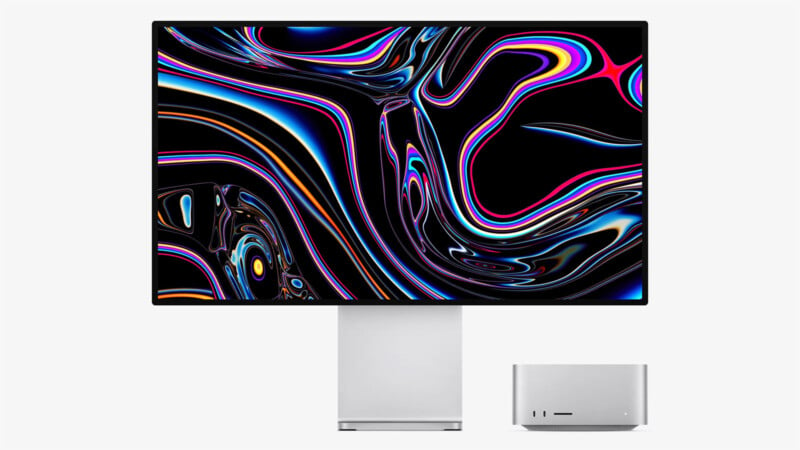Apple Launches M2 Ultra, its Most Powerful Processor Ever
![]()
At today’s Worldwide Developer Conference (WWDC) keynote, Apple unveiled its most powerful M2 chip a year after launching its original M2 chip.
Apple M2 Ultra
After launching the original M2 chip last June, Apple followed it up with upgraded M2 Pro and M2 Max chips earlier this year, featured in the latest MacBook Pro models.
The Apple M2 Ultra capitalizes on the gains made by the M2 Pro and Max chips and takes the M2 and Apple’s processors to an unprecedented level of performance.
![]()
Apple M2 Ultra Key Features
The M2 Ultra doubles the performance and dies of the M2 Max, since it’s a pair of M2 Max chips combined, like what Apple did with its M1 Ultra and M1 Max silicon.
The M2 Ultra includes 134 billion transistors — 20 billion more than M1 Ultra. It supports 192GB of unified memory and its CPU is 20 percent faster than M1 Ultra. The GPU is much better, too, 30 percent faster than its predecessor.
“M2 Ultra delivers astonishing performance and capabilities for our pro users’ most demanding workflows, while maintaining Apple silicon’s industry-leading power efficiency,” says Johny Srouji, Apple’s senior vice president of Hardware Technologies. “With huge performance gains in the CPU, GPU, and Neural Engine, combined with massive memory bandwidth in a single SoC, M2 Ultra is the world’s most powerful chip ever created for a personal computer.”
M2 Ultra sports customized technologies to help drive incredible performance, including a 32-core Neural Engine with 31.6 trillion operations per second, which is 40 percent faster than M1 Ultra.
The M2 Ultra’s media engine has twice the capabilities of M2 Max, which bodes well for ProRes video encoding and video editing tasks. M2 Ultra can play back a mind-blowing 22 streams of 8K ProRes 422 video simultaneously, something Apple claims that no PC chip can match.
The M2 Ultra can also drive up to six Pro Display XDR monitors, which totals more than 100 million pixels.

Apple M2 Chips Compared
To put the new M2 Ultra’s performance into perspective, looking at what came before is important.
The original Apple M2 chip offers significant gains over the original M1, which debuted in a trio of new Mac computers in 2020. Compared to the original M1, the base M2 is nearly four times faster concerning video processing and just over seven times faster for image processing. The M2 includes an 8-core CPU and 10-core GPU in its base variant. Overall, the M2 is 1.4 times faster than the M1 (18 percent faster CPU and 35 percent faster GPU).
As for the M2 Pro, it includes either a 10- or 12-core CPU, which promises about 20 percent better performance than the M1 Pro. It has double the memory bandwidth speed of the M1 Pro and up to 32GB of unified memory, or RAM. The M2 Pro’s GPU has up to 19 cores, resulting in a 30 percent improvement in graphics performance. The chip’s Neural Engine is 40 percent faster.
![]()
Simply put, the M2 Max is the M2 Pro, except faster. It pushes the gains realized by the M2 Pro even further, offering up to 38 GPU cores and 30 percent better graphics than the M1 Max. The M2 Max has a 12-core CPU that is up to 20 percent faster than the M1 Max’s CPU. The M2 Max has double the memory bandwidth of the M2 Pro and supports up to 96GB of unified memory.
Enter the M2 Ultra, which is yet another massive improvement within Apple’s M2 chip family. When Apple announced the M1 Ultra featured in the first-generation Mac Studio, it was Apple’s most powerful chip ever, and it remains potent to this day. The M1 Ultra’s system on a chip includes 114 billion transistors, up to 128GB of memory, a 20-core CPU and a 64-core GPU.
M2 Ultra channels the M1 Ultra’s pioneering spirit and turns the dial up to 11. The new M2 Ultra includes 24 CPU cores, 16 of which are high-performance, and up to 76 graphics cores. The GPU can also be configured with 60 cores, which is a more affordable option for users.
Developing…
Image credits: Apple